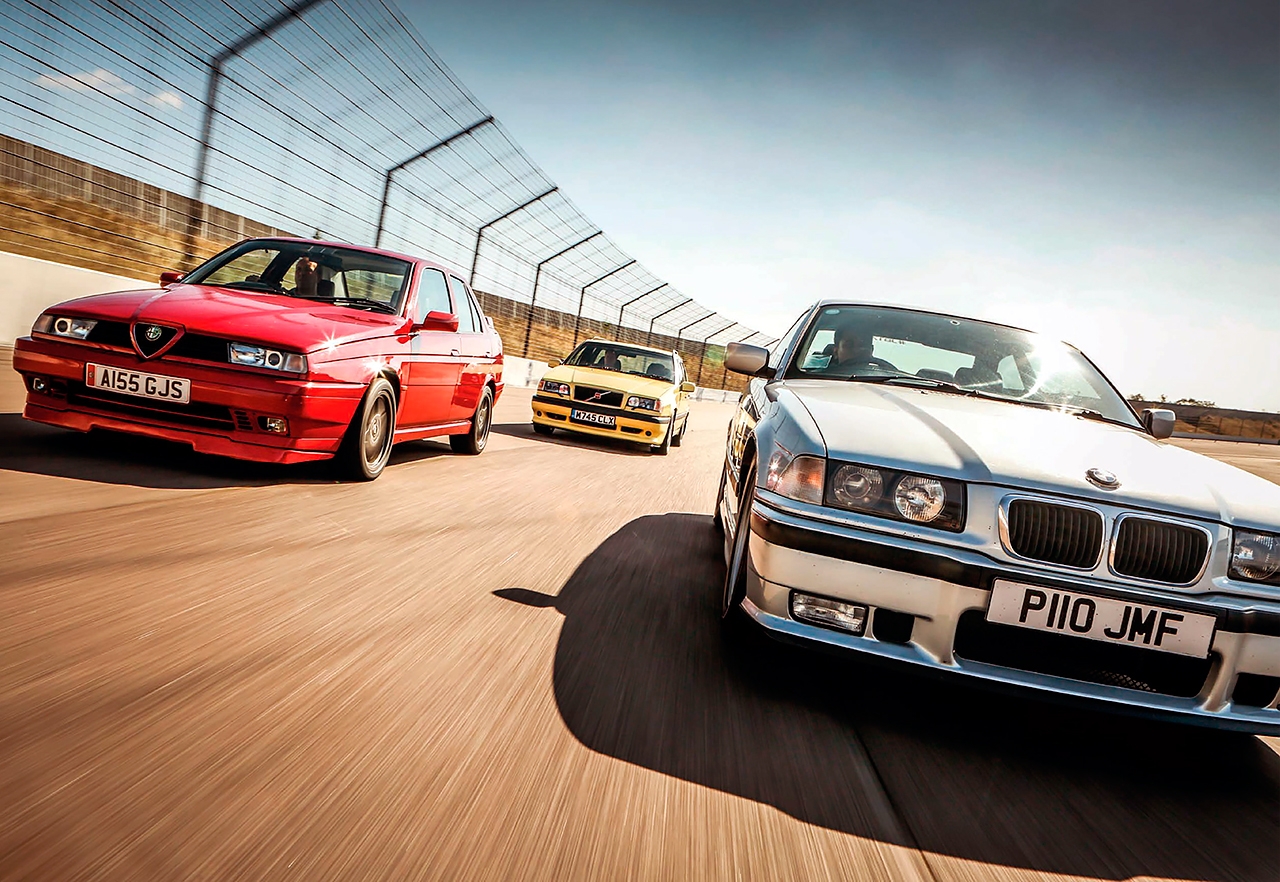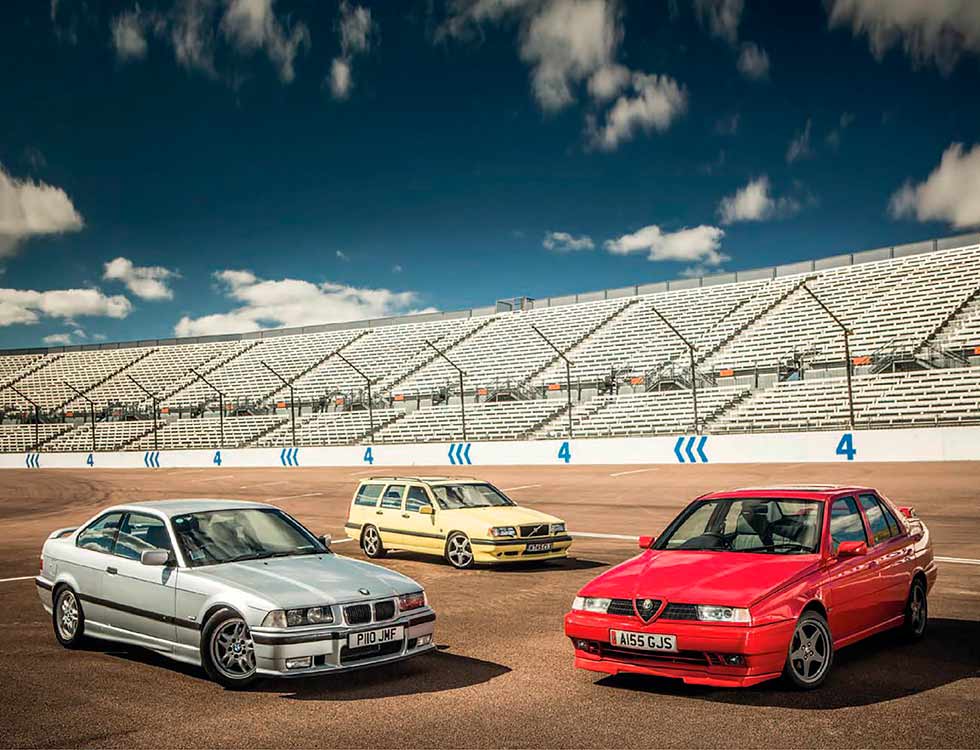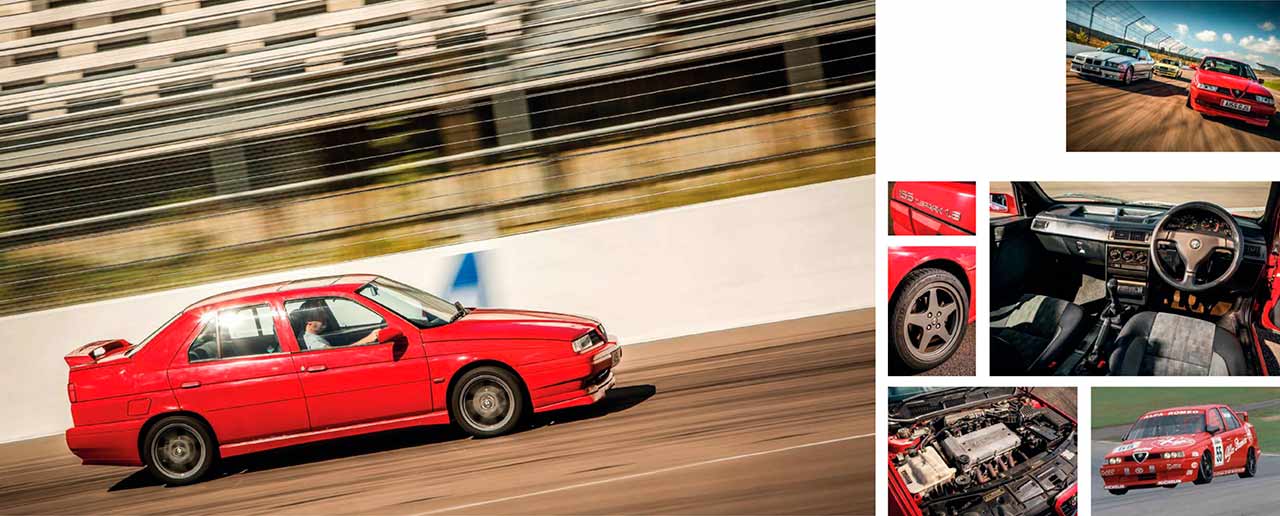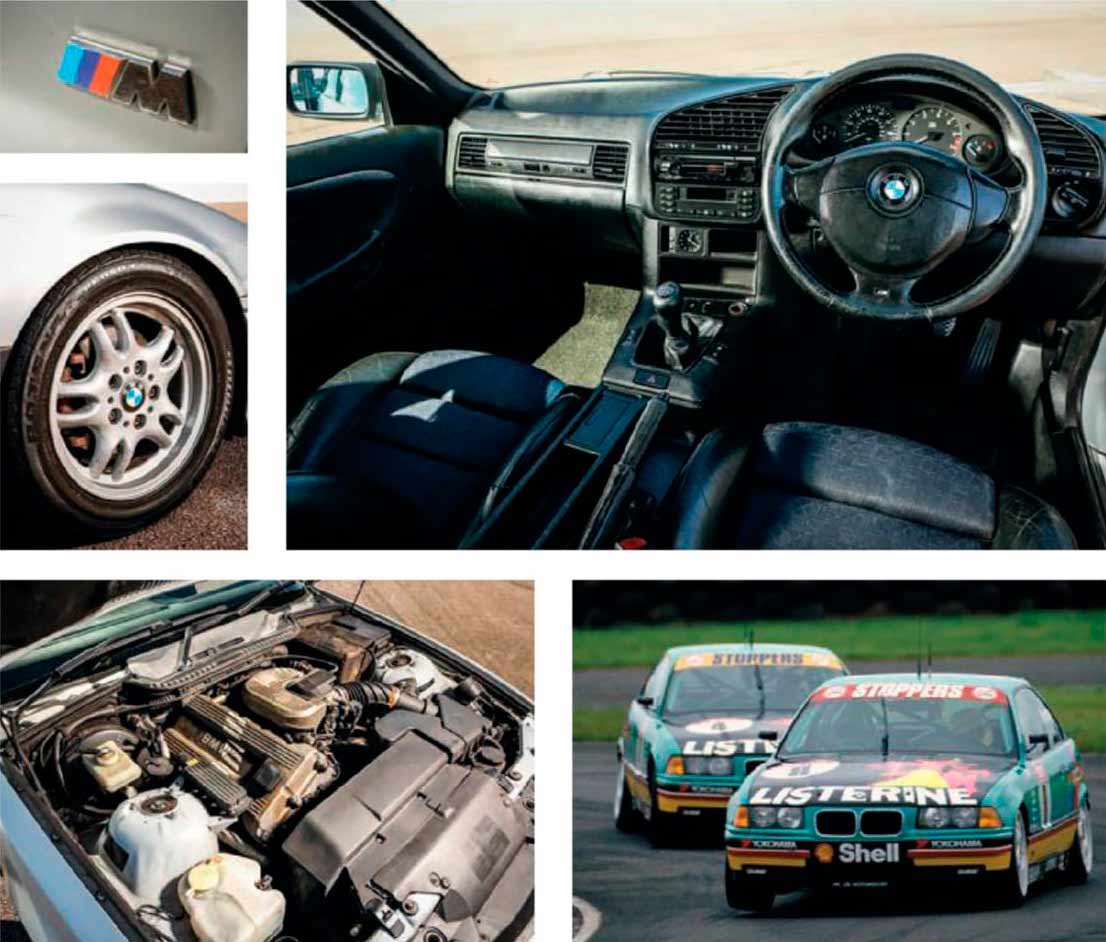
Getting back on track: tintop rivals from BMW, Volvo and Alfa. BTCC 1994 revisited Roadgoing racers lock horns again. Win on Sunday… …sell on Monday: the old adage was spot-on in the case of the 1994 British Touring Car Championship. Ross Alkureishi compares Alfa-Romeo 155, BMW 318iS Coupe 3 Series E36 and Volvo 850. Photography Tony Baker/LAT.
Innovation, a ‘unique’ entry, controversy, two stuffed Collies, political manoeuvring – oh, and a bit of high-octane racing. Ladies and gentlemen, I give you the 1994 British Touring Car Championship. Four years on from the initial phasing out of FISA’s complex four-class Group A rules and the adoption of the new 2-litre regulations – maximum engine speed 8500rpm, 950kg minimum weight, 2500 minimum build – Great Britain’s racetracks were rocking to the absolute rafters.
The adoption of mid-range saloons as its basis, which had so worried many in the sport, had proven to be a BTCC masterstroke, with crowds of 30,000-40,000 regularly witnessing the drivers as they did battle. And my, what skirmishes they saw, as many of the big-boy manufacturers – Alfa Romeo, BMW, Renault, Ford, Vauxhall, Nissan, Toyota and Volvo – let loose their wares, while new and existing heroes sought to forge and embellish reputations.

Although the Alfa and the Volvo have an aggressive stance, it’s arguably the BMW that looks sharpest more than 20 years later.
The effect on those watching cannot be underestimated, as the already big-selling models shifted even more units to those wishing to emulate the antics of Steve Soper, John Cleland, Andy Rouse, Will Hoy et al. At the time, the target in the collective crosshairs of manufacturers was ‘family man with a racing bent’. Of little concern would have been the effect on the next generation but, to a man, the owners of the cars that we’ve gathered at Rockingham give one answer as to why they bought their respective modern classics: “Touring Cars.” Prompt them further, and the year 1994 is uttered in hushed tones.
First up, our Italian offering. The other owners mock boo in its presence, and no wonder. Call it bending the rules or using your noggin’, problems ensued from the moment that Alfa Romeo unveiled its 155 TS at a rainy Thruxton on an apt 1 April. It had only gone and built a homologation special for the series – the sole manufacturer to do so.
At considerable cost, 2500 ‘Silverstone’ road cars – ‘Formula’ on the continent – were produced. Each was supplied to a no-doubt nonplussed new owner with additional spacers that, when fitted, raised its Alfa 33-sourced rear wing by 15cm, plus a bag of rivets that enabled the front splitters to be extended.
At point of sale, both were retracted. Even when fitted, the road cars would have gained negligible benefits but on the track it was a different matter, Gabriele Tarquini romping to victory in each of his first five outings.
Despite the fact that an active front differential played at least an equal part in the car’s success, the outcry and laments against the aerodynamic package from rival manufacturers – Ford being most vociferous – prompted the RAC to dock Alfa Corse the points it gained at both Snetterton and Silverstone, although this decision was later overturned on appeal. Matters continued to build to a crescendo and, even though it’d done nothing wrong and refused to retract the front splitters, the 155’s scrutineering ticket was refused before round seven at Oulton Park. The team withdrew in protest. Political machination ensued on both sides, with a compromise reached – Alfa Corse would return for the next round, running with the rear spoiler in its lower position but front splitters extended.

Volvo has the edge in a straight line, but BMW handles beautifully. Below right, clockwide: solid interior; Harvey and Soper at Pembrey, 1992; freerevving ‘four’; multi-spoke alloys; revered M badge.
A rule change on the next homologation date, 1 July, placated other teams to some degree. It enabled them to fit their own combination of rear wings and front splitters, and get somewhat closer. By that time, the Alfa Romeo was flying and would continue gathering points.
So where does that leave the 155 today, other than with two spacers and a bag of rivets in its boot? “I’ve never even fitted them,” reflects owner Gero Sicilia. “Although I have been offered a lot of money to sell them.” Such is the effect of motorsport kudos, it seems.
In the metal, the design is more handsome than it appears in pictures. The brooding front end instantly conjures images of the brutal racer and its forward-sloping wedge-like profile, coupled with the discreet aerodynamic package, lends its stance a sporting aura.
Popping the bonnet reveals Alfa’s venerable Twin Spark engine, here in 1.8-litre eight-valve form – for at least the two preceding decades, Touring Cars bore little mechanical resemblance to their road brethren – while underneath sits a Fiat Type-3 platform of Tipo fame.

Clockwise: Alfa’s wedge profile looks suitably sporting; interior is well laid out but lacks some of the charm of older models; Tarquini at Brands Hatch; the Twin Spark unit is the least powerful here, but it’s a gem and thrives on revs; smart five-spoke alloy wheels; 1.8-litre model ideal for BTCC.
Cabin controls are well set out, even if it’s a tad dull when compared to stylish Alfa interiors of yesteryear. The thick steering wheel and stubby gearlever, however, offer a pleasing tactility. Get on the throttle, though, and it’s the willingness of the rev counter to spin round swiftly that’s most pleasing, and in true Twin Spark style the powerplant’s sweet rasp simply begs you to push it harder. It’s happiest, as is the driver, with the needle buried deep in the frisky zone north of 3500rpm.
Rockingham’s Oval Circuit does leave it feeling a little underpowered, at just 129bhp, but transfer to the International Super Sportscar Circuit and it’s clear that the 155 can cut it in corners. Turn-in is sharp, and while power provokes initial understeer, it tidily tucks in its snout if you lift off gently, enabling you to power out early. Get it wrong, though, and oversteer will have you wildly bumping and thumping your way over the kerbs, Tarquini-style. Is it enough for a true Alfisti to forgive it those humble front-drive origins? I think so.
Despite a history of competition success in PVs 444 and 544, plus its Amazon and 240 Turbo, back in ’94 it was an inconspicuous manufacturing background that the Volvo 850 had to overcome. Snobbery on the road transferred to the racing arena, and was magnified. And if those rumours were true, ye gads…
Volvo’s late-March unveiling of its race car cemented them, and caused uproar. Driver Rickard Rydell later recalled: “Our competitors, who were taking part largely to strengthen their sporting image, were not pleased about having to compete with an estate.”
Numerous jokes circulated the paddocks and appeared in the press: had the company mistaken the competition for the British Towing Car Championship? Would the racing car be fitted with a dog guard in the rear?
The team running the 850 took the ribbing well, and even responded in kind by completing a parade lap of one race heat with a stuffed Collie in the boot of each car, which led to uproar and complaints from the animal-loving UK. This combination of unique body style and ex-canine shenanigans was certainly a bonus for Volvo’s marketing folk, but with minimal testing no one really expected the car to be a front-runner.

Cue Murray Walker’s exclamation as Jan Lammers in the big Swedish beast mixed it at the top table, at Brands Hatch: “They all laughed when Volvo said they would be entering an estate, but they don’t think it’s funny any more.”
Despite limited testing and its increased heft/ inferior weight distribution, the TWR designed, built and raced Volvo proved competitive – in bursts. The estate actually generated less lift because it offset the turbulence caused by the step-down of a saloon’s tail, resulting in it being more stable at high speeds and through corners.
I’ve got a confession to make: the T-5R here is actually a limited-edition model, introduced in 1995. Although 2500 were constructed, that year homologation rules shifted, demanding 25,000 units, so it was never destined to race. In any case, after further aerodynamic rule changes the team switched to saloons.
The 850 SE/GLT in two-litre guise formed the ’1993 and ’1994 homologation basis, but with Rockingham at my command where would be the fun in driving what would be a – sorry, Volvo fans – relatively humdrum offering? Anthony Taylor’s Gul Yellow T-5R, on the other hand, is a rolling contradiction, with its 17in graphite alloy wheels, low-profile Pirelli P-Zero tyres, aggressive front spoiler and lowered suspension, all offset by the company’s ultra-angular design. Never has a designer taken a brief more literally when asked to produce a two-box estate car. The combined result is like being handed a Werther’s Original laced with Angel Dust.
The Porsche-designed five-cylinder engine kicks out 240bhp and it’s delivered with a vicious punch to your lower back, plus a soundtrack that’s part gruff exhaust note and part wildly whistling intake. Drop a cog from fifth to fourth, floor it and the propulsion available is breathtaking.
From 50-70mph, it would demolish most supercars of the era, and with 0-62mph taking just 6.9 secs it leaves our BMW and Alfa on an entirely different motoring plane. Through tight bends, the chassis loses a little composure as it struggles to lay down the power, so you have to keep a light foot on the throttle to avoid spinning the wheels; break traction and things get feral, as you battle to reign in its wild power-on nature.
In period, many lamented the bone-jarring lowered and stiffened suspension as being far too brutal for the road, but here on this ultra-smooth surface it produces phenomenal grip for such a big lump. Forget the leather- and Amarettatrimmed cabin and its vast capacity, forget the plethora of safety aids – this Volvo is all about baring those considerable performance teeth.
Over in the German camp, the BMW 318iS formed the basis for its Team Schnitzer-run offering. For a company on an ‘M’ march, it was a low-key starting point compared to its predecessor, the E30 M3. Still, it had previous success with the ‘lowly’ 635CSi E24 and in ’1993 the 318i had romped to the BTCC title with a one-two finish for Joachim Winkelhock and Steve Soper.

Clockwise: on a smooth surface, the Volvo grips tenaciously; well-equipped cabin; turbocharged ‘five’ gives epic levels of performance; mighty brakes behind alloys; T-5R was a limited edition. Rickard Rydell attacks the kerbs at Thruxton during Volvo’s 1994 campaign.
The following year, the team was caught on the hop, as Alfa Romeo snatched the aerodynamic initiative from the original proponents of the be-winged race fiend. With a weight penalty for rear-wheel drive, the Schnitzer cars spent the first part of the season in the midleague doldrums, until a change in rules and a weight reduction transformed the BMW and suddenly made it a winner again. Alfa had a fight on its hands, and from the Silverstone Grand Prix encounter (round 12) onwards the rejuvenated BMWs stormed to victory in five of the remaining 10 fixtures.
When it originally arrived in April 1992, the new E36 instantly consigned to history the E30’s boxy profile. It just looked so modern and fresh. In truth, it still does. Compared to both Alfa and Volvo it looks a generation newer. In profile, particularly, it certainly puts the 155 to shame, looking far more resolved.
Owner Charles Thesiera travelled from Newcastle to the south coast to find this Polar Silver iS – sourcing a clean one is tough – and like most Beemers of the period it has an epic mileage, yet it still drives absolutely on the button. This generation of 3 Series was a real step-change in terms of build quality and styling, and was raced in i saloon and iS coupé forms. The cabin is discreet but of high quality, with an understated solidity to it, while the steering and brakes are significantly sharper than both of our other cars. This later 1.9-litre iS’ M44 engine doesn’t sound as soulful as the Alfa’s, but it’s just as eager and shifting through the fivespeed manual ’box is a pleasure.
But it’s in the handling department where it excels. The E36 inherited the advanced Z-axle from the Z1 and all coupés came with M-Tech suspension, which included lower, firmer springs and different dampers. When combined with its rear-wheel-drive layout it means that it can be pushed harder through corners before its outer limits become apparent. Where the Alfa and Volvo start scrabbling frantically for traction with their respective front wheels, the 318iS simply sticks and powers through.
Back on the track in 1994, BMW Schnitzer’s surge came too late. Despite Alfa Corse’s win ratio tailing off, Tarquini – who survived a spectacular barrel-rolling, door-swinging crash at Knockhill – picked up second-place finishes in rounds 15 and 16, before sealing the championship with another second place in round 18 and a win in round 19, both at Silverstone.
The Volvo 850 estates proved competitive but erratic, eventually finishing 13th and 14th in the championship, yet the sight of them launching over the kerbs, all four wheels off the ground, remains to this day an enduring BTCC image from that breathless season. And despite the 1995 switch to saloons, it set the groundwork for Rickard Rydell’s 1998 triumph in an S40.
Of the road cars, the BMW and Alfa offer tantalising glimpses into the worlds of Soper and Tarquini, but even if it never formed the basis for the racer, it’s the T-5R that comes closest to supplying your Touring Car fix. It reflects the qualities that Alfa’s Giampero Simoni once used to describe the BTCC – “Is frightening. Is fast. Is funny”– but perhaps the greatest attraction of our trio is that you could buy all of them for a fraction of the cost of one Group A-inspired road car. No wonder the Super Touring era is so fondly remembered.
Thanks to Stuart Mills; Volvo Enthusiasts’ Club (www.volvoenthusiastsclub.co.uk); Colin and Robert Hughes; VolvoTuning.net; Alfa Romeo Owners’ Club (www.aroc-uk.com); Steve Ball; Stuart Taylor; Kos Loizou
‘THE BMW CAN BE PUSHED HARDER THROUGH CORNERS BEFORE ITS OUTER LIMITS BECOME APPARENT’
TECHNICAL DATA BMW 318iS E36
Sold/number built 1993-’1998/191,053
Construction steel monocoque
Engine iron-block, alloy-head, dohc 1895cc inline ‘four’, multi-point BoschMotronic 5.2 fuel-injection
Max power 140bhp @ 6000rpm
Max torque 133lb ft @ 4300rpm
Transmission five-speed manual, RWD
Suspension independent, at front by MacPherson struts rear multi-link, double wishbones, coil springs; anti-roll bar f/r
Steering power-assisted rack and pinion
Brakes discs (ventilated at front), ABS
Length 14ft 7in (4433mm)
Width 5ft 7in (1700mm)
Height 4ft 7in (1390mm)
Wheelbase 8ft 10in (2700mm)
Weight 2778lb (1260kg)
Mpg 32.1
0-62mph 9.9 secs
Top speed 132mph
Price new £19,355 (1998)
Now £1500-£10,000
‘FORGET THE PLETHORA OF SAFETY AIDS, THE VOLVO IS ALL ABOUT BARING ITS TEETH’
TECHNICAL DATA VOLVO 850 T-5R
Sold/number built 1995/2500
Construction steel monocoque
Engine all-alloy, dohc, turbocharged 2319cc inline ‘five’, multi-pointdirect-port fuel injection
Max power 240bhp @ 5600rpm
Max torque 221lb ft @ 2300rpm
Transmission five-speed manual, FWD
Suspension independent, at front by MacPherson struts rear trailing arms, coil springs; anti-roll bar f/r
Steering power-assisted rack and pinion
Brakes discs (ventilated at front), ABS
Length 15ft 6in (4720mm)
Width 5ft 9in (1760mm)
Height 4ft 8in (1415mm)
Wheelbase 8ft 9in (2660mm)
Weight 3113lb (1412kg)
Mpg 31
0-62mph 6.9 secs
Top speed 155mph (electronically limited)
Price new £28,840
Now £1500-£7000
Meanwhile, in Germany
Over in the Deutsche Tourenwagen Meistershaft, things were a little more hardcore. Why limit yourself to 2-litres and minimal aerodynamic appendages when there’s so much more automotive pleasure to be had? In 1993, it adopted the more liberal FIA Class 1 regulations, which allowed a maximum displacement of 2.5-litres and designs of six cylinders. Pretty much anything else went, with extreme engine, chassis and aerodynamic modifications allowed. Some of the cars were among the most technologically advanced of their time, such as Alfa Romeo’s 155 V6 TI with semi-automatic six-speed ’box, four-wheel drive and 420bhp delivered at a screaming 11,800rpm.
Then there was Opel’s V6 4×4 Calibra, boasting 500bhp and an active suspension system. Or Mercedes-Benz’s rear-drive 440bhp AMG C-Class, which could have its entire front end – engine, suspension and cooling system – removed and replaced in less than 15 minutes; it would storm to the ’94 DTM title with Klaus Ludwig at the wheel. Other notable DTM fire-breathers to compete that year included non-factory BMW E36 M3s and Ford Mustangs.
‘ALFA HAD GONE AND BUILT A HOMOLOGATION SPECIAL, THE ONLY MARQUE TO DO SO’
TECHNICAL DATA ALFA 155 TS SILVERSTONE
Sold/number built 1994-’95/2500
Construction steel monocoque
Engine all-alloy, dohc 1773cc inline ‘four’, Bosch Motronic multi-point fuel injection
Max power 129bhp @ 6100rpm
Max torque 122lb ft @ 4800rpm
Transmission five-speed manual, FWD
Suspension independent, at front by MacPherson struts rear trailing arms; coil springs, telescopic dampers, anti-roll bar f/r
Steering power-assisted rack and pinion
Brakes discs (ventilated at front), ABS
Length 14ft 7in (4443mm)
Width 5ft 8in (1730mm)
Height 4ft 8in (1425mm)
Wheelbase 8ft 4in (2540mm)
Weight 2646lb (1200kg)
Mpg 29.7
0-62mph 10.3 secs
Top speed 124mph
Price new £13,990 Now £1000-£5000





